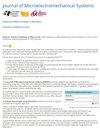MEMS-Oriented Single-Crystalline-Silicon Through-Silicon-Via Based on Filling and Oxidation of Silicon Powders
IF 2.5
3区 工程技术
Q2 ENGINEERING, ELECTRICAL & ELECTRONIC
引用次数: 0
Abstract
This paper, for the first time, introduces filling and oxidation of silicon powders (FOSP) into through-silicon insulation, and develops a single-crystalline-silicon (SCS) through-silicon-via (TSV) for MEMS front-end process. Submicron silicon powders are filled into annular trenches on one side of low-resistivity SCS wafer by a silica-gel scraper, which is followed by surface cleaning to wipe off residual powders and oxidation to turn these trench-filled incompact silicon powders into solidified SiO2 liner respectively. After the same process is carried out on the other side, isolated conductive silicon pillars are formed and strongly anchored to the substrate. The FOSP-based SCS TSV wafer is tolerant to high temperature and acid, and hardly influenced by coefficient of thermal expansion (CTE) mismatch. Thinning step is omitted in its fabrication process, which guarantees low total thickness variation (TTV). A 6-inch FOSP-based SCS TSV wafer with基于硅粉填充和氧化的mems定向单晶硅通孔
本文首次将硅粉(FOSP)填充氧化制成通硅绝缘,开发了一种用于MEMS前端工艺的单晶硅(SCS)通硅通孔(TSV)。利用硅胶刮板将亚微米级硅粉填充在低阻SCS晶圆的一侧的环形沟槽中,然后进行表面清洗去除残留的硅粉,再进行氧化处理,将这些填充在沟槽中的松散硅粉分别变成固化的SiO2衬里。在另一侧进行相同的过程后,形成隔离的导电硅柱并牢固地固定在衬底上。基于fosp的SCS TSV晶圆具有耐高温、耐酸性,且几乎不受热膨胀系数(CTE)失配的影响。在制造过程中省去了减薄步骤,保证了低总厚度变化(TTV)。成功研制了厚度为$380\mu $ m、通孔为20480孔的6英寸fosp基SCS TSV晶圆。对其结构强度、气密性、TTV和翘曲进行了研究。测量结果表明,20V时每TSV的泄漏电流约为0.2pA,导电硅柱的电阻范围为$50\Omega $ ~ $140\Omega $(电阻率为$0.017\sim 0.022\Omega \cdot $ cm,直径为$66\mu $ m/ $88\mu $ m)。此外,通过测试过程,证明基于fosp的SCS TSV晶圆符合金属热压键合的要求,形成可以进行磨削和深度反应离子蚀刻(DRIE)的集成晶圆。本文提出的SCS TSV技术不受晶片厚度和DRIE的深宽比的限制,可以应用于大尺寸SCS晶片。[2024-0127]
本文章由计算机程序翻译,如有差异,请以英文原文为准。
求助全文
约1分钟内获得全文
求助全文
来源期刊

Journal of Microelectromechanical Systems
工程技术-工程:电子与电气
CiteScore
6.20
自引率
7.40%
发文量
115
审稿时长
7.5 months
期刊介绍:
The topics of interest include, but are not limited to: devices ranging in size from microns to millimeters, IC-compatible fabrication techniques, other fabrication techniques, measurement of micro phenomena, theoretical results, new materials and designs, micro actuators, micro robots, micro batteries, bearings, wear, reliability, electrical interconnections, micro telemanipulation, and standards appropriate to MEMS. Application examples and application oriented devices in fluidics, optics, bio-medical engineering, etc., are also of central interest.
 求助内容:
求助内容: 应助结果提醒方式:
应助结果提醒方式:


